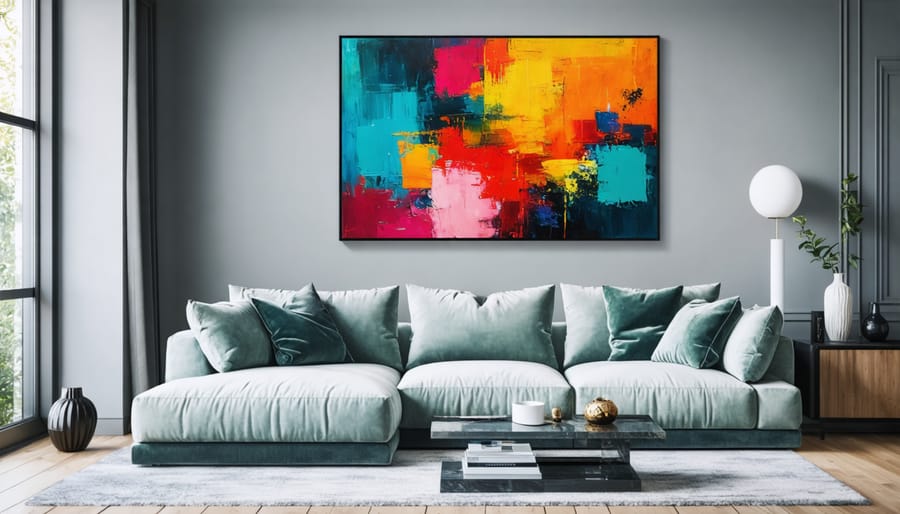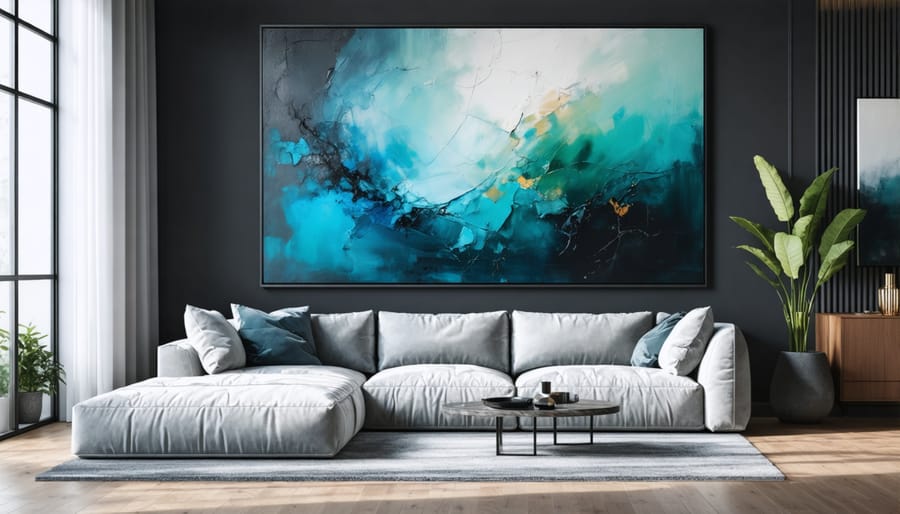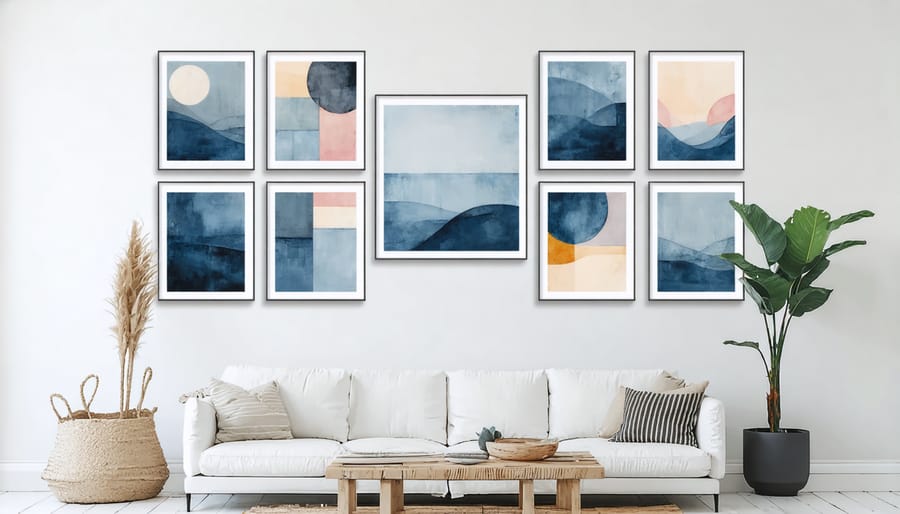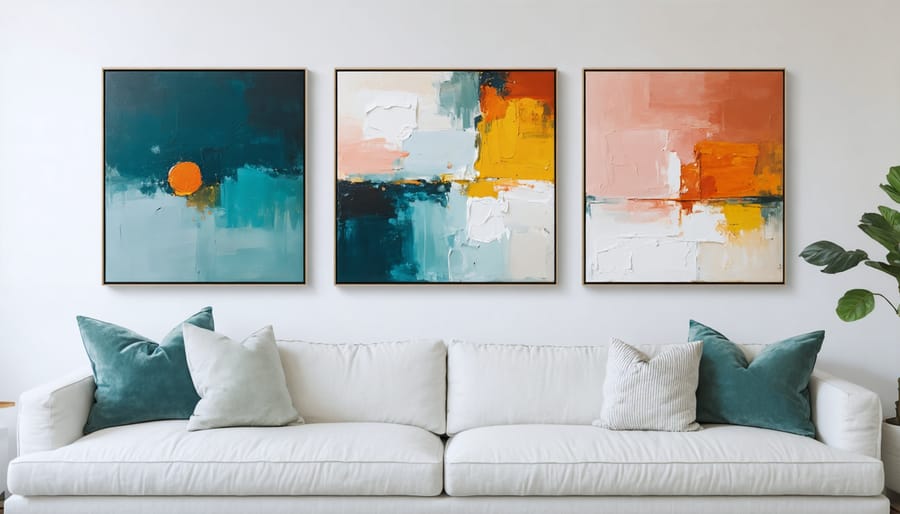
Transform Your Space: Art That Elevates Interior Design
Transform any room instantly by treating artwork as a focal point rather than an afterthought. The way art transforms interior spaces goes far beyond mere decoration – it establishes mood, defines color schemes, and creates visual harmony throughout your home. Select pieces that reflect both your personal style and the room’s intended function, whether it’s energizing artwork for social spaces or calming pieces for bedrooms. Position larger works at eye level, approximately 57-60 inches from the floor, and allow them to guide furniture placement rather than the reverse. Layer smaller pieces in collected groupings to create dynamic gallery walls that tell your story while maintaining visual balance. Consider scale carefully – artwork should occupy about two-thirds of the wall space above furniture to achieve proper proportion. Mix mediums thoughtfully, combining paintings, photographs, and dimensional pieces to add depth and interest while maintaining a cohesive look through consistent framing or color themes.
Why Art Matters in Interior Design
Creating Emotional Connection
Art has the unique ability to transform a space from merely functional to deeply personal and emotionally resonant. When chosen thoughtfully, artwork can evoke specific moods, trigger cherished memories, and create an immediate emotional response in both residents and visitors. A serene landscape painting might bring a sense of calm to a hectic home office, while vibrant abstract pieces can energize a living room and spark conversation.
Personal connection is often strongest when the art reflects your experiences, values, or aspirations. Family photographs, converted into gallery-style displays, can turn a hallway into a timeline of precious moments. Local artwork can help ground your space in your community’s culture, while travel souvenirs can remind you of memorable adventures.
Consider how different pieces make you feel before incorporating them into your space. Does that bold contemporary piece make you feel inspired? Does the vintage poster bring back nostalgic memories? The most successful interior designs use art to create an emotional narrative throughout the home, making spaces feel lived-in and loved rather than simply decorated.
Defining Focal Points
Art can transform an ordinary room into a captivating space by serving as a strategic focal point. When used thoughtfully, artwork draws the eye and anchors the entire design scheme of a room. The key is to identify the natural focal areas in your space – typically these are walls opposite the entrance, above fireplaces, or behind primary furniture pieces like sofas and beds.
Creating an effective focal point with art isn’t just about hanging the biggest piece you can find. Consider the room’s purpose and traffic flow. In living rooms, position statement pieces where they can be appreciated from multiple seating angles. For dining rooms, artwork should be visible but not compete with conversation.
Scale plays a crucial role – artwork should be proportionate to the wall space and surrounding furniture. A good rule of thumb is that art should occupy about two-thirds of the wall space above furniture. You can also create impact by grouping smaller pieces into a gallery wall, which serves as a collective focal point while adding visual interest and personality to your space.
Remember that lighting can enhance your focal point. Strategic placement of track lighting or picture lights can dramatically highlight your chosen artwork and amplify its impact on the room’s overall design.

Choosing Art That Works
Scale and Proportion
Selecting the right size artwork for your space can make the difference between a room that feels polished and one that seems off-balance. A general rule of thumb is that artwork should occupy about 60-75% of the wall space where it’s meant to hang, whether that’s above a sofa, in a hallway, or as a standalone piece.
For larger walls, consider using statement pieces or gallery walls. When hanging art above furniture, aim for the piece to be roughly two-thirds the width of the furniture beneath it. For instance, if your sofa is 84 inches wide, look for artwork or a grouping that spans approximately 56 inches.
Height placement is equally important. The center of your artwork should typically hang at eye level, about 57-60 inches from the floor. When placing art above furniture, leave 6-8 inches of space between the bottom of the frame and the top of your furniture piece.
Don’t be afraid to go big in small spaces – an oversized piece can actually make a room feel larger. For high-ceiling rooms, try vertical artwork or stacked pieces to draw the eye upward and emphasize the room’s height. Remember that matting and frames contribute to the overall dimensions, so factor these into your measurements when selecting pieces for your space.
Color and Style Coordination
Coordinating art with your existing décor requires a thoughtful approach to color and style harmony. Start by identifying your room’s color palette, including both dominant and accent colors. Look for artwork that either complements these colors or introduces intentional bold contrasts in design for visual interest.
Consider the 60-30-10 rule: use 60% of your dominant color, 30% of a secondary color, and 10% for accent colors. Your artwork can either fall within this scheme or become that striking 10% accent that ties everything together. For neutral rooms, colorful art pieces can serve as perfect focal points, while vibrant spaces might benefit from more subdued artwork that balances the overall energy.
Don’t feel constrained by matching exact colors – look for pieces that share similar undertones or complementary hues. If you’re working with a modern vintage style, consider how traditional art forms can blend with contemporary elements through color coordination.
Remember that frames play a crucial role in style coordination. Choose frames that echo other design elements in your space, such as metal finishes on light fixtures or wood tones in furniture. This creates a cohesive look that makes your art feel intentionally curated rather than randomly placed.
Art Placement Strategies
Height and Spacing Guidelines
The key to successful artwork placement lies in following time-tested height and spacing guidelines. For most spaces, hang artwork at eye level, with the center of the piece positioned 57-60 inches from the floor. This height creates a comfortable viewing experience and maintains visual balance in the room.
When hanging art above furniture, leave 6-8 inches of space between the bottom of the frame and the top of your furniture piece. This creates a cohesive connection between the elements while maintaining proper proportions. For gallery walls, keep spacing between frames consistent, typically 2-3 inches apart, to create a polished, professional look.
In dining rooms, consider hanging artwork slightly lower since people are usually seated. For large walls, follow the two-thirds rule: the artwork or grouping should take up roughly two-thirds of the wall width to avoid looking undersized. When hanging multiple pieces, treat them as a single unit and apply the same center-point rule.
For high ceilings, resist the urge to hang artwork too high – stick to the eye-level rule to maintain intimacy and visual impact. Remember to consider the viewing distance; larger spaces may require bigger pieces or groupings to maintain proper scale.

Room-Specific Considerations
Each room in your home presents unique opportunities for artistic expression. In living rooms, larger statement pieces often work best, as they can anchor the space and create a focal point for conversation. Consider gallery walls that tell your story through a collection of varied artworks.
Bedrooms call for more serene and personal pieces. Choose art that promotes relaxation and reflects your individual style. Abstract pieces in calming colors or nature photography can help create a peaceful atmosphere perfect for rest.
Dining rooms benefit from artwork that complements the dining experience. Food-themed art, still life paintings, or pieces that spark conversation work particularly well here. Consider scale – larger pieces can make a dramatic impact in formal dining spaces.
For kitchens, opt for more practical art choices that can withstand humidity and cooking elements. Vintage food advertisements, colorful prints, or even artistic plate arrangements can add personality without compromising functionality.
Bathrooms present an opportunity for playful or unexpected art choices. Water-themed pieces, botanical prints, or even abstract works can transform this utilitarian space into something special. Just ensure any artwork is properly protected from moisture.
In home offices, choose inspiring pieces that enhance productivity while maintaining professionalism. Maps, motivational prints, or sophisticated abstract works can create the perfect balance of style and function.
Budget-Friendly Art Solutions
DIY Art Projects
Creating your own artwork adds a personal touch to your interior design while being budget-friendly. Try creating an abstract canvas piece by using acrylic paints in your room’s color scheme – simply apply bold brushstrokes or use the pour-painting technique for a modern look. For a sophisticated wall display, frame a collection of pressed flowers or botanical prints you’ve photographed yourself.
Transform everyday items into artistic statements by painting geometric patterns on plain ceramic vases or creating a gallery wall with decorated mirrors. Children’s artwork can be elevated by using professional framing and thoughtful arrangement. For a unique conversation piece, try string art on a wooden board using nails and colored thread to create intricate patterns or meaningful words.
Digital photography enthusiasts can create striking wall art by printing and framing their best shots in a cohesive series. For texture lovers, try creating a woven wall hanging using yarn, driftwood, and fabric scraps. Remember, the key to successful DIY art is choosing projects that complement your space’s existing style while reflecting your personal creativity.

Alternative Art Sources
Finding beautiful artwork doesn’t have to break the bank. Online marketplaces like Etsy and Society6 offer unique, affordable prints from independent artists, while local art fairs and student exhibitions can be treasure troves for original pieces at reasonable prices. Digital art subscription services now allow you to display rotating collections on smart screens, perfect for those who enjoy variety.
Consider exploring print-on-demand services where you can customize artwork to match your color scheme, or check out vintage shops and flea markets for one-of-a-kind finds. Many museums also offer high-quality print reproductions of famous works, adding cultural sophistication to your space at a fraction of the cost.
For the DIY-inclined, creating your own artwork can be both cost-effective and personally meaningful. Frame children’s artwork, personal photographs, or try your hand at abstract painting. You can also explore our recommended home decor products for affordable art pieces that make a statement without compromising on style.
Common Art Integration Mistakes
While incorporating art into your interior design can elevate your space, there are several common mistakes that can diminish its impact. One of the most frequent errors is choosing artwork that’s either too small or too large for the wall space. A tiny piece can look lost on a large wall, while an oversized piece can overwhelm a small room.
Another pitfall is hanging artwork at the wrong height. The general rule is to position the center of the piece at eye level, approximately 57-60 inches from the floor. Many people hang their art too high, creating an uncomfortable viewing experience and disrupting the room’s visual flow.
Matching art too closely to your furniture or decor can create a space that feels artificial and staged. While your artwork should complement your room’s color scheme, it shouldn’t be an exact match to your throw pillows or curtains. Instead, aim for pieces that create interesting contrasts while maintaining harmony with your overall design.
Poor lighting is another common oversight. Beautiful artwork loses its impact when poorly lit or placed in direct sunlight, which can cause fading and damage. Consider installing proper art lighting or positioning pieces where natural light enhances rather than detracts from their beauty.
Lastly, many people make the mistake of cluttering their walls with too many pieces. This creates visual chaos and prevents individual artworks from making their intended impact. Remember that negative space is just as important as the art itself in creating a balanced, sophisticated interior.
Art in interior design is more than just decoration – it’s the soul of your space and a powerful tool for self-expression. Throughout this guide, we’ve explored how artwork can transform rooms, create focal points, and establish emotional connections within your living spaces. From selecting pieces that speak to your personal style to understanding proper placement techniques, you now have the knowledge to make informed decisions about incorporating art into your home.
Remember that you don’t need an unlimited budget to create an artistically inspiring space. Whether you’re investing in original pieces, choosing quality prints, or creating your own artwork, the key is thoughtful curation and placement. Start small with one statement piece or gallery wall, and allow your collection to grow organically over time.
As you begin your journey of incorporating art into your interior design, trust your instincts while keeping the basic principles in mind. Consider scale, color harmony, and the overall flow of your space. Don’t be afraid to experiment with different styles, mediums, and arrangements until you find what works best for your home.
The most successful interior spaces tell a story, and art is your most powerful storytelling tool. Take the first step today – whether it’s selecting your first piece or reimagining the placement of your existing collection. Your space will thank you with renewed energy and personality that truly reflects who you are.
